Pakistan’s political environment is as dynamic as it is complex. With a history marked by military coups, political upheaval, and a vibrant civil society, the country faces a multitude of pressing political issues in 2024. This article aims to dissect the current political landscape, examining key issues ranging from governance challenges to economic instability, and their implications for the future.
Historical Context
A Brief Overview of Pakistan’s Political History
Pakistan, established in 1947, has experienced significant political turmoil throughout its history. From military dictatorships to democratic governments, the political landscape has shifted dramatically. Understanding this historical context is essential for grasping the current issues facing the nation.
Key Milestones in Recent History
- 2008-2018: A decade marked by democratic governance following the end of military rule.
- 2018: Imran Khan’s Pakistan Tehreek-e-Insaf (PTI) party comes to power, promising a new political vision.
- 2022: Political instability leads to Khan’s ousting through a no-confidence vote, leading to significant shifts in power dynamics.
Current Political Issues in Pakistan
1. Political Instability and Governance Challenges
The political landscape in Pakistan remains fraught with instability. After Imran Khan’s ousting, the political environment has been characterized by power struggles and public unrest.
- Coalition Government Dynamics: The current coalition government, formed after Khan’s removal, faces challenges in maintaining unity among diverse political factions.
- Public Discontent: There has been rising public dissatisfaction with the government, driven by economic hardships and unmet expectations.
2. Economic Struggles
Pakistan’s economy is under severe strain, exacerbating political tensions. Key economic issues include:
- High Inflation: The country is grappling with soaring inflation rates, affecting the cost of living for ordinary citizens.
- Debt Crisis: Pakistan’s growing external debt has raised concerns about economic sustainability and fiscal responsibility.
3. Human Rights and Civil Liberties
Human rights issues remain a contentious topic in Pakistan’s political discourse.
- Freedom of Speech: Journalists and activists often face threats and censorship, leading to a chilling effect on free expression.
- Minority Rights: The protection of minority rights, including religious and ethnic minorities, continues to be a significant challenge.
Key Players in Pakistan’s Politics
1. Pakistan Tehreek-e-Insaf (PTI)
Imran Khan’s PTI continues to play a crucial role in the political landscape despite his ousting.
- Opposition Dynamics: PTI has mobilized public support, criticizing the current government’s handling of various issues, especially the economy.
- Future Prospects: Khan’s continued influence in politics raises questions about future electoral prospects for PTI.
2. Pakistan Muslim League-Nawaz (PML-N)
The PML-N has emerged as a dominant force in the current coalition government.
- Leadership Challenges: The party is navigating internal conflicts and public scrutiny over its governance performance.
- Electoral Strategy: The PML-N’s approach to upcoming elections will be pivotal in shaping Pakistan’s political future.
3. Pakistan Peoples Party (PPP)
The PPP remains an important player in Pakistani politics, advocating for progressive policies.
- Coalition Politics: The PPP’s role in the coalition government has been to balance power dynamics and ensure stability.
- Regional Influence: The party continues to hold significant sway in Sindh province, impacting national politics.
Social Movements and Civil Society
1. Rise of Social Movements
Social movements in Pakistan have gained momentum, addressing various issues such as women’s rights, climate change, and governance.
- Youth Activism: Young people are increasingly engaged in political activism, demanding accountability and reform.
- Role of NGOs: Non-governmental organizations are pivotal in advocating for social change and human rights protection.
2. Media’s Role in Political Discourse
The media landscape in Pakistan is diverse but faces challenges.
- Journalism Under Threat: The safety of journalists remains a significant concern, impacting investigative reporting.
- Digital Media: Social media platforms have become vital for public discourse, allowing citizens to voice their opinions and mobilize.
Foreign Relations and Geopolitical Considerations
1. Pakistan-India Relations
Relations with India continue to be a sensitive topic, affecting national security and foreign policy.
- Kashmir Dispute: The longstanding conflict over Kashmir remains unresolved, with periodic flare-ups in tensions.
- Diplomatic Engagements: Attempts at dialogue have often been met with skepticism from both sides.
2. Relations with China and the West
Pakistan’s foreign relations are marked by its strategic partnership with China and complicated ties with Western countries.
- CPEC and Economic Dependence: The China-Pakistan Economic Corridor (CPEC) has significant implications for Pakistan’s economic future, but also raises concerns about dependency.
- Western Relations: Relations with Western nations are influenced by issues like human rights and counter-terrorism efforts.
The Future of Pakistan’s Political Landscape
1. Upcoming Elections and Political Prospects
With elections on the horizon, the political landscape in Pakistan is poised for further changes.
- Election Preparedness: The readiness of political parties to engage in a competitive electoral process will shape the outcome.
- Voter Sentiment: Understanding public sentiment towards political parties will be crucial for predicting electoral success.
2. Need for Reforms
Addressing the underlying issues affecting governance and public trust will be vital.
- Electoral Reforms: Implementing reforms to ensure fair elections and transparency in political processes is imperative.
- Strengthening Institutions: Building strong institutions that uphold democratic values and the rule of law will be essential for Pakistan’s stability.
Conclusion
The political issues facing Pakistan today are multifaceted and deeply intertwined with its historical context and socio-economic realities. As the nation navigates through political instability, economic challenges, and social movements, the path forward will require collaboration among political factions, civil society, and citizens. Only by addressing these challenges head-on can Pakistan hope for a more stable and prosperous future.


